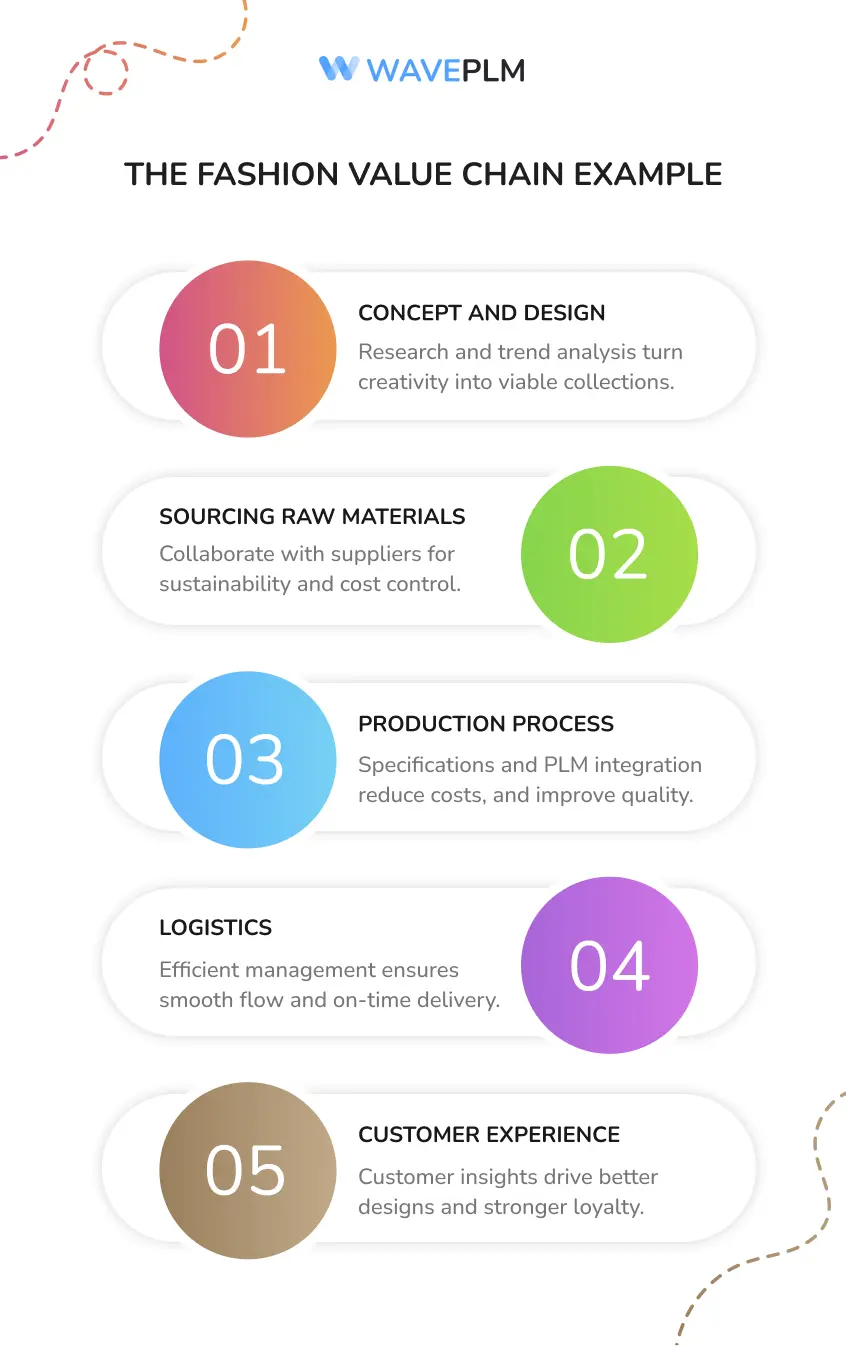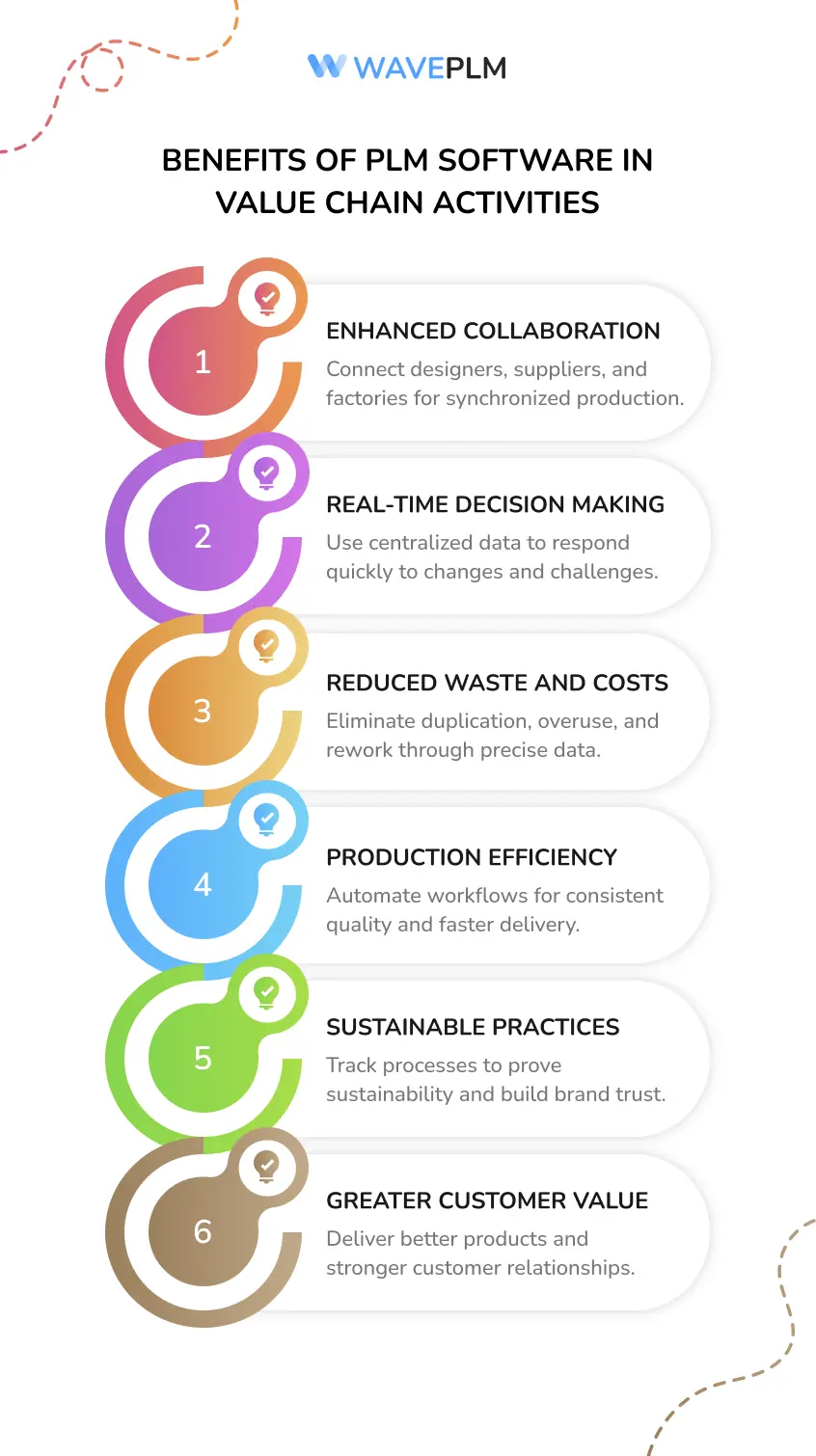
In today’s fashion world, efficiency means more than just speed. The most successful brands have moved from managing simple supply chains to mastering the art of creating value at every step. This evolution — from supply chain to value chain — defines how companies achieve true competitive advantage and sustaining superior performance.
Modern fashion demands flexibility, transparency, and sustainability. The difference between supply chain and value chain helps businesses understand where they can gain more value, not only by moving goods but by enhancing creativity, customer satisfaction, and brand reputation. Through PLM software, these two systems merge into one streamlined, data-driven model that supports the entire fashion production process — from the first sketch to the final product reaching the customer.
Understanding the Difference: Supply Chain vs. Value Chain
|
Aspect |
Supply Chain |
Value Chain |
|---|---|---|
|
Focus |
Movement of raw materials, goods, and components |
Adding value at each stage to increase customer satisfaction |
|
Goal |
Reduce costs, manage logistics, and optimize production |
Create competitive advantage and build customer loyalty |
|
Process |
Linear flow: raw materials → manufacturing → distribution → sales |
Strategic cycle: research → design → sourcing → production → marketing → after-sales support |
|
Key Activities |
Procurement, inventory management, logistics |
Design, innovation, sustainability, communication, and customer feedback |
|
Driver |
Efficiency and cost control |
Creativity, collaboration, and perceived value |
|
Toolset |
ERP systems, logistics platforms |
PLM software, analytics, and value chain analysis tools |
The supply chain focuses on coordination — ensuring that materials and goods move efficiently through multiple stages. The value chain goes further, linking each step of the business process to create customer value and organizational performance. When integrated through PLM software, these processes align seamlessly, giving fashion companies a single, intelligent workflow.
The Fashion Value Chain: From Concept to Customer
A modern fashion value chain involves dozens of interconnected steps — from sourcing raw materials to creating marketing campaigns. Each process adds value, and each decision impacts customer experience and sustainability.
Example of a Fashion Value Chain
- Concept and Design – Research and trend analysis transform creative ideas into viable fashion collections.
- Sourcing Raw Materials – Teams collaborate with suppliers to ensure ethical sourcing, transparency, and cost control.
- Production Process – Detailed specifications and PLM integrations reduce production costs, increase quality, and minimize waste.
- Inbound and Outbound Logistics – Efficient management ensures smooth material flow and timely delivery of finished goods.
- Customer Experience and After Sales Support – Insights from customer feedback improve future designs and reinforce brand loyalty.
The chain starts with creativity and ends with the customer. But to reach maximum value, every stakeholder — from designers to manufacturers — must work collaboratively. That’s where PLM software creates a powerful foundation.

How PLM Software Strengthens Value Chain Thinking
Product Lifecycle Management (PLM) systems enable fashion brands to connect creative, operational, and technical teams in one digital ecosystem. Instead of working in silos, teams share real-time data, reducing delays and miscommunication.
|
Function |
How PLM Adds Value |
|
Design Collaboration |
Designers and developers create digital samples, reducing time spent on manual revisions. |
|
Sourcing Transparency |
Teams manage supplier data, certifications, and material sourcing in one shared dashboard. |
|
Production Data Control |
Managers track production status, timelines, and quality metrics in real time. |
|
Digital integration reduces overstocking and improves cost allocation. Learn more about sustainable product development and green innovation in fashion. |
|
|
Sustainability Tracking is essential for fashion brands. Learn more about creating an efficient fashion calendar to optimize your production process and help meet your sustainability and deadline goals. |
Brands monitor environmental impact and compliance automatically. |
This digital transformation allows companies to perform detailed value chain analysis. By examining each stage, they can identify competitive advantage opportunities, reduce inefficiencies, and deliver superior performance consistently.
From Supply to Value: The Shift in Fashion Strategy
Traditional supply chains were built for speed and low cost. But today’s consumers demand more — transparency, ethical production, and personalized products. The modern value chain adds creativity and sustainability to the equation.
|
Traditional Supply Chain |
Value Chain Powered by PLM |
|
Limited to logistics and cost control |
Focuses on innovation, design, and customer experience |
|
Slow data communication |
Real-time digital collaboration |
|
Manual quality checks |
Automated quality assurance and feedback loops |
|
Minimal visibility |
Full transparency from raw materials to final product |
This shift creates a culture of value chain thinking, where efficiency comes not from shortcuts but from collaboration and informed decision-making. With PLM software, the entire production process becomes faster, smarter, and more aligned with customer needs.
Integrating Supply Chain Management into the Value Chain
Supply chain management remains essential for any fashion company. Yet, when integrated with PLM, it transforms from a cost-driven process to a value-driven strategy. The result is a connected system where every department contributes to both product quality and customer value.
|
Integration Goal |
Outcome |
|
Connect design and sourcing |
Align creativity with supplier capabilities and reduce lead times |
|
Optimize inbound logistics |
Improve delivery schedules and raw material utilization |
|
Strengthen outbound logistics |
Ensure fast, accurate product distribution |
|
Track sustainability metrics |
Generate transparent reports and support compliance |
|
Manage external stakeholders |
Foster better relationships with partners and vendors |
This integration supports continuous improvement and helps companies create and sustain superior performance. It also strengthens market positioning by improving customer trust and satisfaction.
Benefits of PLM Software in Value Chain Activities
1. Enhanced Collaboration
PLM connects external stakeholders — from designers to factories — allowing for synchronized production and quicker problem resolution.
2. Real-Time Decision Making
With centralized production data, teams can react instantly to supply fluctuations or design changes.
3. Reduced Waste and Costs
Precise data helps eliminate fabric overuse, duplication, and late-stage rework — key drivers of unnecessary spending.
4. Improved Manufacturing Efficiency
Automating value chain activities ensures consistency in product quality and faster response to market demands.
5. Sustainable and Ethical Operations
By tracking each process, brands prove their sustainability commitments, increasing customer loyalty and global competitiveness.
6. Greater Customer Value
The ultimate result of effective PLM implementation is better products, stronger relationships, and deeper brand connection.

Implementing PLM in Your Own Value Chain
Implementing PLM requires thoughtful planning, training, and collaboration. It’s not just software — it’s a strategy for transforming your company’s operations into a continuous value loop.
|
Step |
Action |
Result |
|
1 |
Map all primary and secondary activities |
Identify weak points, redundancies, and improvement opportunities |
|
2 |
Conduct a value chain analysis |
Determine how each stage impacts customer experience and profitability |
|
3 |
Integrate PLM across departments |
Ensure all teams work from the same, updated data source |
|
4 |
Manage inventory and logistics digitally |
Reduce storage costs and streamline distribution |
|
5 |
Train employees on PLM workflows |
Encourage collaboration and data literacy across departments |
|
6 |
Track results continuously |
Use analytics to refine processes and improve organizational performance |
With each iteration, companies gain deeper insight into their own value chain, enabling better decisions and sustained growth.
Real-World Example: Competitive Advantage Through PLM
Imagine a mid-size European fashion label sourcing from multiple continents. Previously, each supplier communicated via email, causing production delays and confusion. PLM changed that.
- Design and Development: Digital libraries replaced spreadsheets, reducing design approval time by 40%.
- Sourcing Raw Materials: Suppliers upload certifications and materials specs directly to the system.
- Production Oversight: Real-time production dashboards show order status and resolve bottlenecks early.
- Logistics: Inbound and outbound logistics sync automatically with warehouse data.
- After Sales Support: Customer feedback data feeds back into design planning.
Within one season, the brand cut waste by 20%, shortened lead times, and improved its competitive edge in the global value chain.
Key Takeaways
|
Topic |
Insight |
|
Value Chain Thinking |
Links all processes from concept to customer experience |
|
Supply Chain Focuses |
Must evolve from logistics-only to value-driven collaboration |
|
PLM Software |
Enables unified data flow across creative and operational teams |
|
Competitive Advantage |
Achieved through visibility, sustainability, and innovation |
|
Key Differences |
Supply chain focuses on logistics; value chain focuses on customer value and innovation |
Final Thoughts
Fashion companies can no longer rely on outdated supply chain models. True efficiency lies in creating value at every stage. Through value chain thinking and PLM software, brands transform their operations into agile, sustainable systems that connect design, production, and customer engagement.
The future belongs to companies that treat every activity — from sourcing raw materials to after-sales support — as a chance to create customer value and achieve superior performance. By combining supply chain management with the strategic insights of the value chain.





Leave a Reply